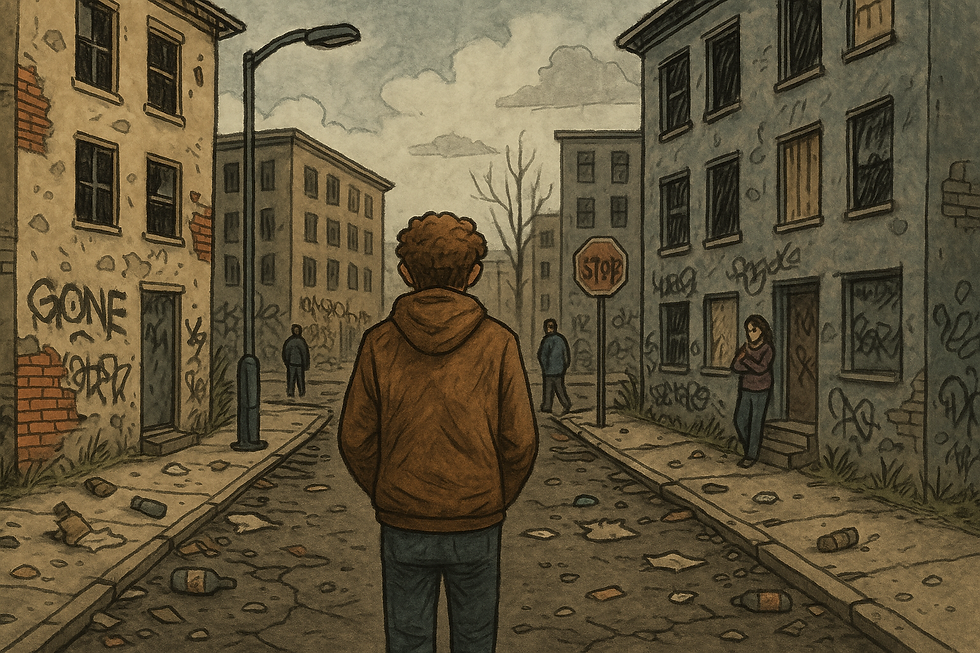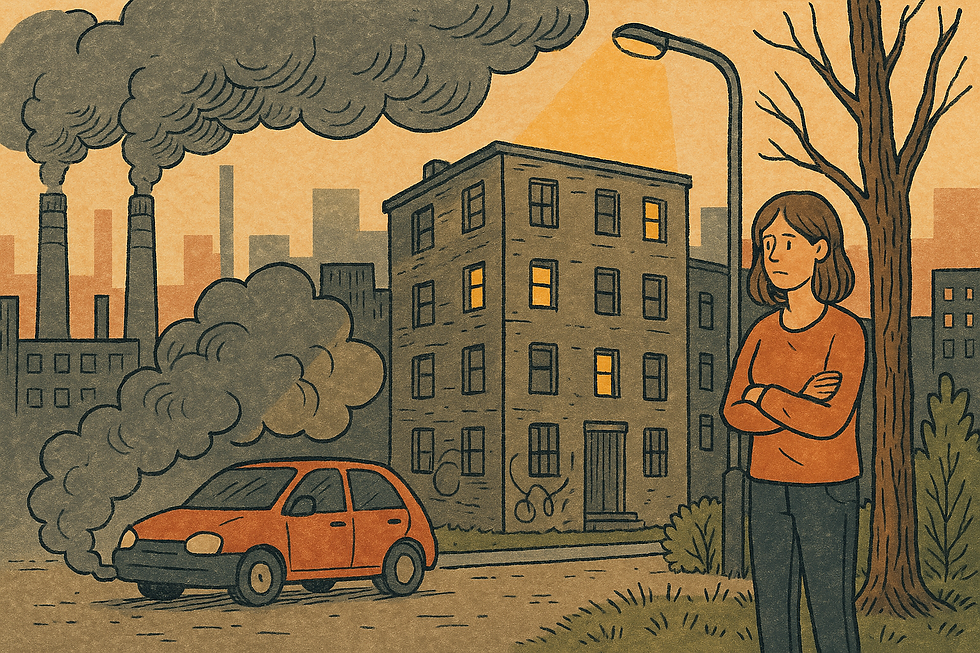City Living and the Mind: Why Urban Life Might Be Bad for Your Brain
- Dominic Borkelmans

- Jul 9
- 5 min read
By 2050, over 70% of the global population is expected to live in cities1. And for good reason, urban centres offer access to jobs, diverse communities, culture, and convenience. But there’s a growing body of evidence suggesting that the fast pace, noise, and density of city life may come at a hidden cost: our mental health.
The idea isn’t new. As early as the 1930s, researchers observed higher rates of psychotic disorders in dense urban areas like Chicago2. Since then, dozens of studies across nearly all 200 countries have confirmed that living in a city is associated with an increased risk of developing common mental disorders (CMDs) like depression, anxiety, and schizophrenia3. Some research even estimates that city dwellers face a 2–3 times higher risk of developing schizophrenia compared to their rural counterparts4. But what is it about cities that gets under our skin and into our brains?
The Hidden Social Costs of Urban Life
One major culprit is the erosion of social cohesion. Despite the crowds, cities can be isolating. Urban neighbourhoods tend to have weaker community ties and lower levels of social trust, what researchers call “social capital”6. Without stable, supportive relationships, people are more vulnerable to mental distress. Fast urbanisation and high residential turnover make this worse by disrupting the bonds that normally form in more stable, close-knit communities7.
Adding to the strain is something called “neighbourhood disorder”, the sense that your surroundings are falling apart. Litter, graffiti, broken windows, these visual cues may seem superficial, but studies show they have real psychological consequences. According to the broken windows theory, these signs of neglect signal danger and instability, which in turn elevate stress and feelings of helplessness8. Even worse, stress can distort our perceptions, leading to a vicious cycle: as your mental health declines, urban stressors feel even more threatening9.
Neighbourhood crime amplifies the social effects. Interestingly, it's not the actual crime rates that matter most; it’s how safe (or unsafe) people feel that predicts their mental health outcomes. A strong sense of threat can trigger chronic stress responses, leading to withdrawal, sleep problems, and ultimately, clinical disorders like depression and anxiety10.

Environmental Stressors You Can’t See (But Your Brain Can)
While social factors are crucial, the physical environment also plays a major role in urban mental health. One of the most well-documented environmental risks is air pollution. Cities are hotspots for fine particulate matter, tiny particles like PM₂.₅ and gases such as NO₂, produced by traffic and industry. These pollutants can reach the brain via the bloodstream or through the olfactory system and are associated with increased risk of depression, anxiety, and even schizophrenia11-12. Alarmingly, these effects have been observed even at pollution levels deemed “safe” by EU standards12.
Another (in)visible disruptor? Light pollution. Urban areas don’t sleep, and neither do our brains when bathed in artificial light at night. Streetlights, screens, and neon signs can emit light levels up to 150 lux, compared to just the 0.1–0.3 lux emitted by natural moonlight13. This kind of light exposure messes with circadian rhythms, disrupts sleep, and increases the risk of developing CMDs14.
And while cities are full of stimuli, they often lack one of the most calming ones: nature. Access to green space, whether it’s a park, a tree-lined street, or just a visible patch of sky, is consistently linked to better mental health outcomes15. Studies have found that even small increases in greenery can lead to measurable reductions in CMD rates. The presence of green space may encourage physical activity, social interaction, or simply offer a moment of visual and psychological relief. Interestingly, people with higher impulsivity traits (a known risk factor for mental illness) benefit even more from exposure to nature16.

What Can We Do About It?
Fortunately, city life doesn’t have to come at the expense of mental well-being. A range of evidence-based interventions, both preventive and reactive, can help reverse these trends.
On the preventive side, urban planners can promote social cohesion by investing in community centres, local events, and shared public spaces7. Cities can reduce air pollution through low-emission zones, better public transport, and stricter regulations11. Simple lighting adjustments, such as using warmer bulbs and dimming streetlights at night, can quickly limit the impact of light pollution13. And perhaps most importantly, cities should add more green space, distributed equitably and designed to encourage social and physical activity15.
Reactive strategies are equally critical. Cleaning up neglected neighbourhoods, improving infrastructure, and reducing crime can have immediate positive effects on residents’ mental health10. Equally, expanding access to community-based mental health services, especially in low-income areas, is essential for those already struggling17. Addressing housing quality and affordability, often overlooked in mental health interventions, is another key step in supporting urban mental well-being18.
Final Thoughts
Cities are here to stay, and so is urbanisation. But as we continue to reshape the way we live, we must also rethink the environments that shape our minds. The research is clear: urban life can increase our vulnerability to mental health challenges, but with thoughtful planning and targeted interventions, that risk is far from inevitable. We have the tools to build cities that don’t just sustain us economically but also support our psychological health. As urban populations grow, mental health must become a central pillar of city design, not an afterthought.
References
Dye, C., Reeder, J. C., Terry, R. F., & Zachariah, R. (2008). Science
Faris, R. E. L., & Dunham, H. W. (1939). University of Chicago Press
Van der Wal, M., et al. (2021). Psychological Medicine
Vassos, E., Pedersen, C. B., Murray, R. M., Collier, D. A., & Lewis, C. M. (2015). Schizophrenia Bulletin
Krabbendam, L., et al. (2021). Psychological Medicine
McKenzie, K. (2008). Global Social Policy
Matheson, F. I., et al. (2006). Social Science & Medicine
Sampson, R. J., & Raudenbush, S. W. (2004). Social Psychology Quarterly
Newbury, J. B., et al. (2017). Development and Psychopathology
Baranyi, G., et al. (2021). Social Science & Medicine
Bakolis, I., et al. (2021). Social Psychiatry and Psychiatric Epidemiology
Braithwaite, I., et al. (2019). Environmental Health Perspectives
Cao, M., Xu, T., & Yin, D. (2023). Journal of Environmental Sciences
Alvaro, P. K., Roberts, R. M., & Harris, J. K. (2013). Sleep
Nutsford, D., Pearson, A. L., & Kingham, S. (2013). Public Health
Bakolis, I., et al. (2018). BioScience
Anakwenze, U., & Zuberi, D. (2013). Health & Social Work
Singh, A., Daniel, L., Baker, E., & Bentley, R. (2019). American Journal of Preventive Medicine



